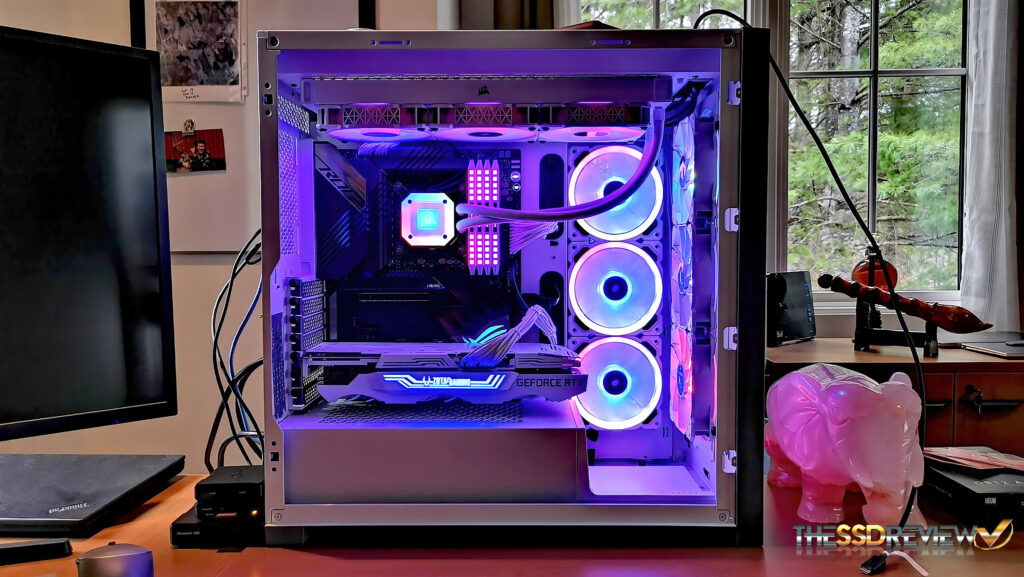TSSDR TEST BENCH AND PROTOCOL
SSD testing at TSSDR differs slightly, depending on whether we are looking at consumer or enterprise storage media. In today’s testing, we will be evaluating the Corsair MP600 Pro XT Gen4 NVMe SSD in our newest Intel Gen 4 Test Bench. This PC has been optimized to provide the absolute highest performance available using our SSD Optimization Guide.
INTEL Z590 PCIe 4.0 TEST BENCH
For this Test Bench, the CPU C-States, Enhanced Intel SpeedStep Technology (EIST) and Intel Speedshift (P-States) have not been disabled. As you will see below, the system is also bumped to 5.3GHz with memory at full speed in its XMP 2 profile.
The components of this Test Bench are detailed below. All hardware is linked for purchase and product sales may be reached by a simple click on the individual item. As well, the title is linked back to the individual build article where performance testing can be validated. Clicking on the Title below will bring you to our complete report on this new Gen 4 PC system.
INTEL Z590 PCIE 4.0 COMPONENTS (Click for System Report)
| PC CHASSIS: | Corsair 5000X RGB White Tempered Glass Chassis |
| MOTHERBOARD: | ASUS ROG Maximus XIII Z590 Hero Gen 4 |
| CPU: | Intel 11th Gen Core i9-11900K |
| CPU COOLER: | Corsair Hydro Series H150i Capellix White |
| POWER SUPPLY: | Corsair RM850x 80Plus White |
| GRAPHICS: | ZOTAC GeForce RTX 3080 Trinity White |
| MEMORY: | Corsair Dominator Platinum RGB DDR4-3200 32GB |
| STORAGE: | Sabrent Rocket 4 Plus Gen 4 4TB NVMe SSD |
| KEYBOARD: | Corsair K70 RGB Mk. 2 SE White Gaming |
| MOUSE: | Corsair M65 RGB Elite FPS Gaming |
| MONITOR: | Samsung 34″ 1440p WQHD Ultrawide Gaming |
BENCHMARK SOFTWARE
The software in use for today’s analysis is typical of many of our reviews and consists of Crystal Disk Info, ATTO Disk Benchmark, Crystal Disk Mark, AS SSD, Anvil’s Storage Utilities, AJA, TxBench, PCMark 10, as well as true data testing. Our selection of software allows each to build on the last and to provide validation to results already obtained.
CRYSTAL DISK INFO VER. 8.11.2 X64
Crystal Disk Info is a great tool for displaying the characteristics and health of storage devices. It displays everything from temperatures, the number of hours the device has been powered, and even to the extent of informing you of the firmware of the device.
Crystal DiskInfo validates that our SSD is running in PCIe 4.0 x4, using the NVMe 1.4 protocol and confirms that it is TRIM capable.
ATTO Disk Benchmark is perhaps one of the oldest benchmarks going and is definitely the main staple for manufacturer performance specifications. ATTO uses RAW or compressible data and, for our benchmarks, we use a set length of 256mb and test both the read and write performance of various transfer sizes ranging from 0.5 to 8192kb. Manufacturers prefer this method of testing as it deals with raw (compressible) data rather than random (includes incompressible data) which, although more realistic, results in lower performance results.
ATTO performance hits highs of 6.47GB/s read and 6.64GB/s write which are up there with the best we have seen for an SSD of this configuration. This is a definite Seagate Firecuda contender and both are showing similar results.
 The SSD Review The Worlds Dedicated SSD Education and Review Resource |
The SSD Review The Worlds Dedicated SSD Education and Review Resource | 


Thanks for the review.
Please answer, why you say “The Corsair MP600 Pro XT Gen4 NVMe SSD is the second best result we have ever received in testing OS data, just behind that of the Plextor M10P.”
when the WD_Black SN850 makes this 15 GB OS-file transfer according to your test in 62 sec only!
Can you explain how the wd black 850 achieves this, what no other companie’s ssd can do?
The “older” 96-layer nand beats even the new 176-layer nand.
The SSD you are referring to was tested with the AMD Test Bench and the drives compared in this result are all tested with the Intel Test Bench, as stated at the top of the chart. As for that result, that review fully explains our surprise and repeated testing with the same times over and over.
No explanations or guesses how the SN850 achieves that 😉
Any number of the MP600 Pro XT is higher; in some cases by a lot.
I think I found the reason for that in another review: The big 281GB slc cache + controller optimized for 4kB IOs in the first run; second run it gets slower by a lot.
Not normal thing to do I guess?
Can you please explain if all/how many the ssd we see nowadays have
1) static dedicated slc-cache
2) pseudo slc-cache (taken portion from the tlc-nand)
3) dynamic pseudi slc-cache (like 2), but dynamicall adapted, changing size if needed.
If there are changes, how I know as a consumer?
Thanks!
Hi there! Thank you so much for the review. this was helpful and information..